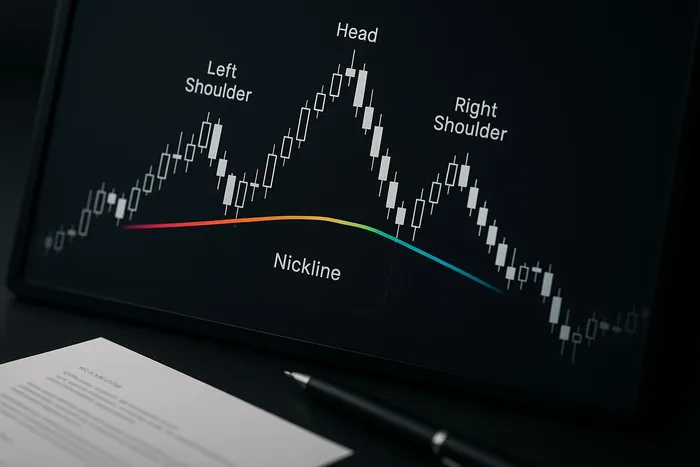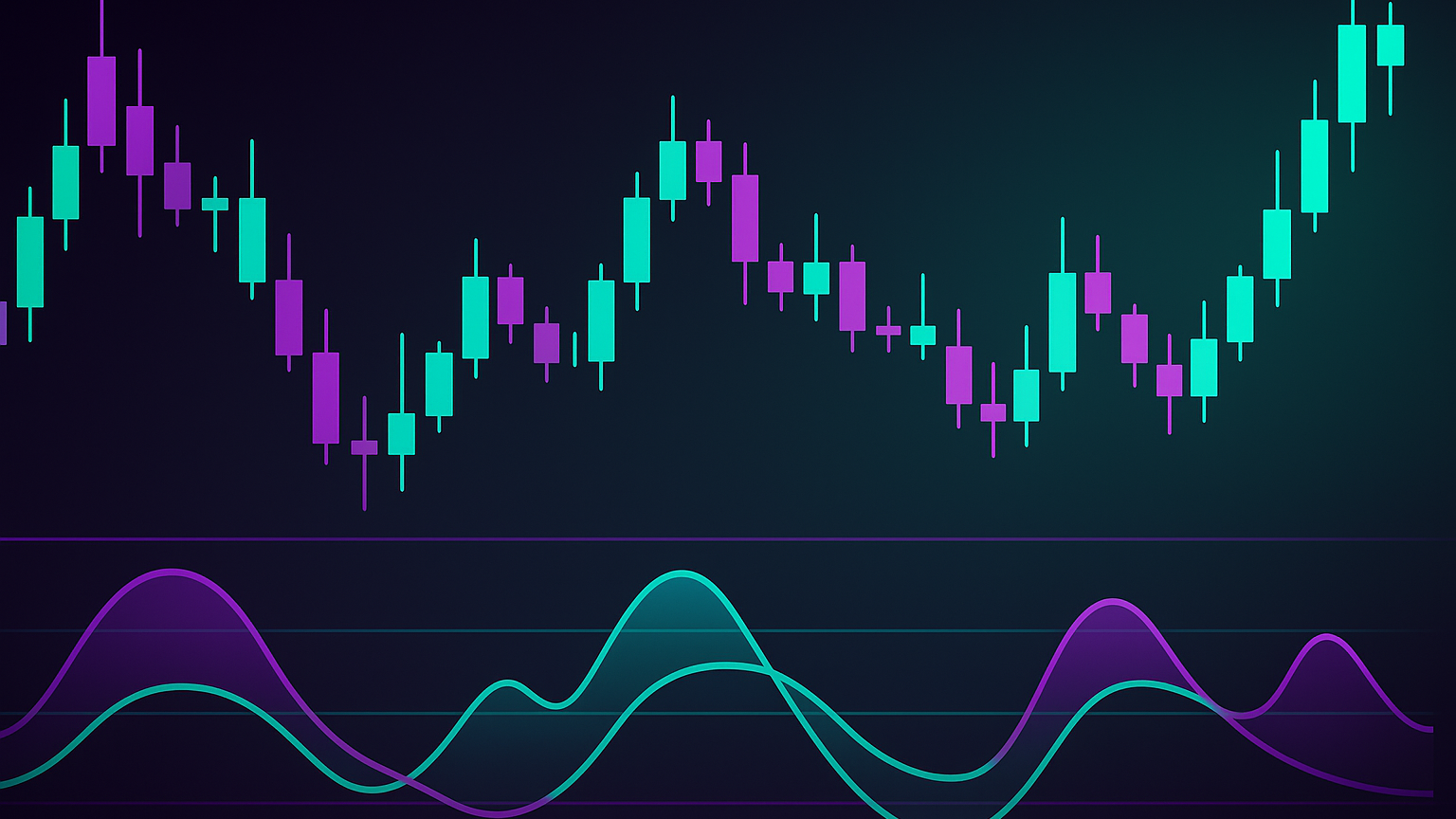Master advanced neckline strategies for head and shoulders patterns to enhance trading accuracy and minimize false signals.
The head and shoulders pattern is a reliable method for spotting trend reversals, but mastering neckline analysis can make or break your trades. Here's a quick breakdown of advanced tactics to refine your approach:
- Neckline Types: Horizontal necklines are the most reliable, while ascending ones are prone to false signals. Descending necklines fall somewhere in between.
- EMA-Based Necklines: Use 20- or 50-period EMAs to adapt to price movements and cut noise in volatile markets.
- Volume Confirmation: Look for volume spikes during breakouts. Tools such as OBV, VWAP and Volume Profile Maps can help validate signals.
- Fibonacci Alignment: Check whether necklines line up with key Fibonacci retracement levels (38.2 percent, 50 percent, 61.8 percent) for precise breakdown points.
- LuxAlgo Toolkits: Automate pattern detection, validate breakouts and back-test strategies with resources such as the PAC Toolkit.
Quick Comparison of Neckline Strategies
| Strategy | Best For | Key Indicators |
|---|---|---|
| Horizontal Necklines | Clear breakouts | Flat neckline, strong price signals |
| EMA-Based Necklines | Volatile markets | 20 / 50 EMA alignment, volume support |
| Volume-Enhanced | High-liquidity assets | OBV / VWAP confirmation |
| Fibonacci Necklines | Precision entry points | Retracement levels (38.2 percent, 50 percent, 61.8 percent) |
ULTIMATE Head-and-Shoulders Pattern Trading Course: Price Action Mastery
Basic Neckline Principles
The neckline plays a key role in head-and-shoulders patterns, acting as critical support or resistance that signals potential trend reversals. Understanding its characteristics helps traders spot solid trading opportunities while steering clear of misleading signals. These basic principles lay the groundwork for the advanced neckline strategies discussed later.
3 Main Neckline Types
The orientation of the neckline significantly affects the reliability of a head-and-shoulders pattern. Each type offers unique trading insights:
Horizontal Necklines
These are considered the most dependable. They form when reaction lows or highs line up to create a flat line, offering clear breakout signals and strong pattern validation.
Ascending Necklines
These appear when the second trough is higher than the first, creating an upward slope. Colin Twiggs of Incredible Charts emphasises caution:
"Never trust a head-and-shoulders pattern where the neckline is clearly ascending (the second trough being higher than the first). Also, the more level the neckline, the more reliable the pattern."
Descending Necklines
These occur when the second trough is lower than the first, resulting in a downward slope. While generally more dependable than ascending necklines, they still require additional confirmation from other technical indicators.
| Neckline Type | Reliability | Key Characteristics |
|---|---|---|
| Horizontal | High | Equal reaction points, clear breakout signals |
| Descending | Moderate | Second trough lower, needs extra confirmation |
| Ascending | Low | Second trough higher, prone to false signals |
Standard Neckline Challenges
Trading neckline breakouts is not without hurdles. Here are some common issues and how to address them:
False Breakouts
Price can temporarily breach the neckline before pulling back into the pattern. To filter out false signals, wait for a candle to close beyond the neckline as confirmation. Watching volume levels also helps verify genuine breakouts.
Pattern Validation
The slope of the neckline directly affects pattern reliability. As noted by Investopedia:
"The neckline is a straight line extended to the right. It signals completion of the pattern when the price drops (top) or rises (inverse) through it." A flatter neckline generally indicates a more trustworthy pattern.
Market-Volatility Impact
High volatility can distort neckline formations, leading to unreliable signals. To counter this, consider:
- Volume and Retest Analysis: Seek high volume on the first peak, moderate on the second, low on the third and a surge during the breakout. Waiting for a retest of the neckline after the break can boost confidence.
- Technical Validation: Use additional tools such as RSI or MACD to confirm the pattern.
Advanced Neckline Methods
In today's fast-paced trading environment, understanding advanced neckline techniques can give traders a sharper edge. These methods build on basic principles, offering precision tools to navigate complex market conditions.
EMA-Based Necklines
Traditional straight-line necklines can oversimplify market dynamics. EMA-based necklines instead use Exponential Moving Averages (EMAs) to define dynamic support and resistance levels. They adjust quickly to price movement and help filter out noise during volatile periods.
- Use a 20-period EMA for short-term trades.
- Opt for a 50-period EMA for longer-term strategies.
- Combine multiple EMAs for added confirmation.
Pairing a 20-period EMA with a 50-period EMA can highlight trend shifts more effectively. Adding volume metrics strengthens reliability, boosting win rates and risk-reward ratios.
Volume-Enhanced Necklines
Volume is crucial in validating breakouts. Indicators such as OBV and VWAP provide deeper insight into breakout strength.
| Volume Indicator | Primary Function | Signal Strength |
|---|---|---|
| OBV | Tracks momentum shifts | Strong when aligned with price direction |
| VWAP | Validates key price levels | Significant when breached with high volume |
| Volume Profile | Highlights critical price zones | Effective for pinpointing support or resistance |
For example, on a daily EUR / USD chart, if price breaks below a neckline with a sharp volume increase, it can confirm a bearish breakout. Combining such volume confirmation with retracement tools creates a strong setup for Fibonacci analysis.
Fibonacci Neckline Analysis
Fibonacci retracement levels add mathematical precision to neckline placement:
- Identify the swing lows between the shoulders.
- Draw Fibonacci retracements from the head to the neckline.
- Confirm the neckline at a key level (38.2 percent, 50 percent or 61.8 percent).
On a cryptocurrency chart, a neckline aligning with a major Fibonacci level often precedes a significant move. Such confluence helps traders refine entries and exits.
Bringing It All Together
The real power of these methods lies in combination. An EMA-based neckline aligning with a key Fibonacci level and confirmed by strong volume creates a high-probability setup. Even with advanced tools, risk management—including stop-loss placement and position sizing—remains essential.
LuxAlgo PAC Toolkit Resources for Neckline Trading

The PAC Toolkit removes guesswork from pattern recognition. Using advanced algorithms, it identifies head-and-shoulders formations and automatically plots necklines across multiple time-frames.
- Real-time pattern detection for rapid identification.
- Dynamic neckline plotting that adapts as the market evolves.
- Multi-time-frame analysis to suit different trading styles.
- Customisable alerts for critical neckline levels.
Additionally, Volumetric Order Blocks highlight zones of intense trading activity, helping traders anticipate neckline breaks. The optimisation engine fine-tunes signal settings for varying market conditions, and the AI Backtesting Assistant validates strategy accuracy across assets and time-frames.
Market Examples
SPY ETF Analysis
The SPDR S&P 500 ETF (SPY) daily chart shows how neckline strategies can pinpoint price targets. A head-and-shoulders top pattern formed during an up-trend, signalling a potential reversal. The head reached $162 while the right shoulder formed at $145. Based on this structure, the correction target was $145, underlining how neckline techniques apply to major ETFs.
Key Points Summary
Recent advancements in neckline analysis are reshaping head-and-shoulders trading strategies. They improve entry timing, reduce false breakouts and help traders manage risk.
EMA-Based Necklines
Recent EUR / USD data shows EMA-based necklines cut false signals by 15 percent versus flat necklines.
Volume-Enhanced Precision
Breakouts with a 20 percent volume surge often outperform. In May 2025 the SPY pattern saw a volume spike followed by a 5 percent drop, illustrating reliability.
Advanced Pattern Recognition
The PAC Toolkit combines volume, EMA-based levels and Fibonacci confluence to simplify actionable pattern detection.
| Neckline Type | Best Market Conditions | Success Indicators |
|---|---|---|
| Down-Angled | Strong bearish trend | 20 percent+ volume increase |
| EMA-Based | Volatile markets | Multi-time-frame confirmation |
| Volume-Enhanced | High-liquidity assets | Clear price-volume divergence |
Risk-Management Framework
Always prioritise risk control. Place stop-loss orders just above the right shoulder and size positions to maintain a healthy risk-reward ratio.
FAQs
How can using EMA-based necklines help filter out market noise during high volatility?
Applying an EMA to the neckline smooths out erratic movements, making it easier to pinpoint dependable breakout or reversal points, particularly in fast-moving markets.
How does volume confirmation help validate a head-and-shoulders pattern breakout?
Volume trends matter: higher volume at the left shoulder, moderate at the head, lower at the right shoulder and a spike on the breakout confirm strength. For the inverse pattern, the sequence is reversed.
How can Fibonacci retracement levels improve the accuracy of neckline analysis in trading?
If a neckline aligns with a major Fibonacci level (such as 38.2 percent or 61.8 percent) it signals a stronger likelihood of price reaction. This helps refine stop-losses and profit targets.
References
- The Head and Shoulders Pattern You Have to Know, LuxAlgo Blog
- Oscillator Matrix Reversal Signals, Documentation
- Volume Profile Maps, Indicator Library
- Fibonacci, Price Action Concepts Documentation
- LuxAlgo Home
- AI Backtesting Platform, LuxAlgo
- LuxAlgo Toolkits Overview
- Range Breakout Signals (Intrabar), Indicator
- Breakouts with Tests & Retests, Indicator
- Dynamic Support and Resistance, Indicator
- Order Blocks, Price Action Concepts Docs
- Price Action Concepts Alerts, Docs
- S&O Backtester Optimisation, Docs
- AI Backtesting Assistant Chat Breakdown, LuxAlgo Blog
- Candle Body Support and Resistance, Indicator
- Incredible Charts, Technical Analysis
- Investopedia Financial Literacy Resource Center
- Head and Shoulders Trading Course, YouTube
- PAC Toolkit Alerts Video, YouTube








